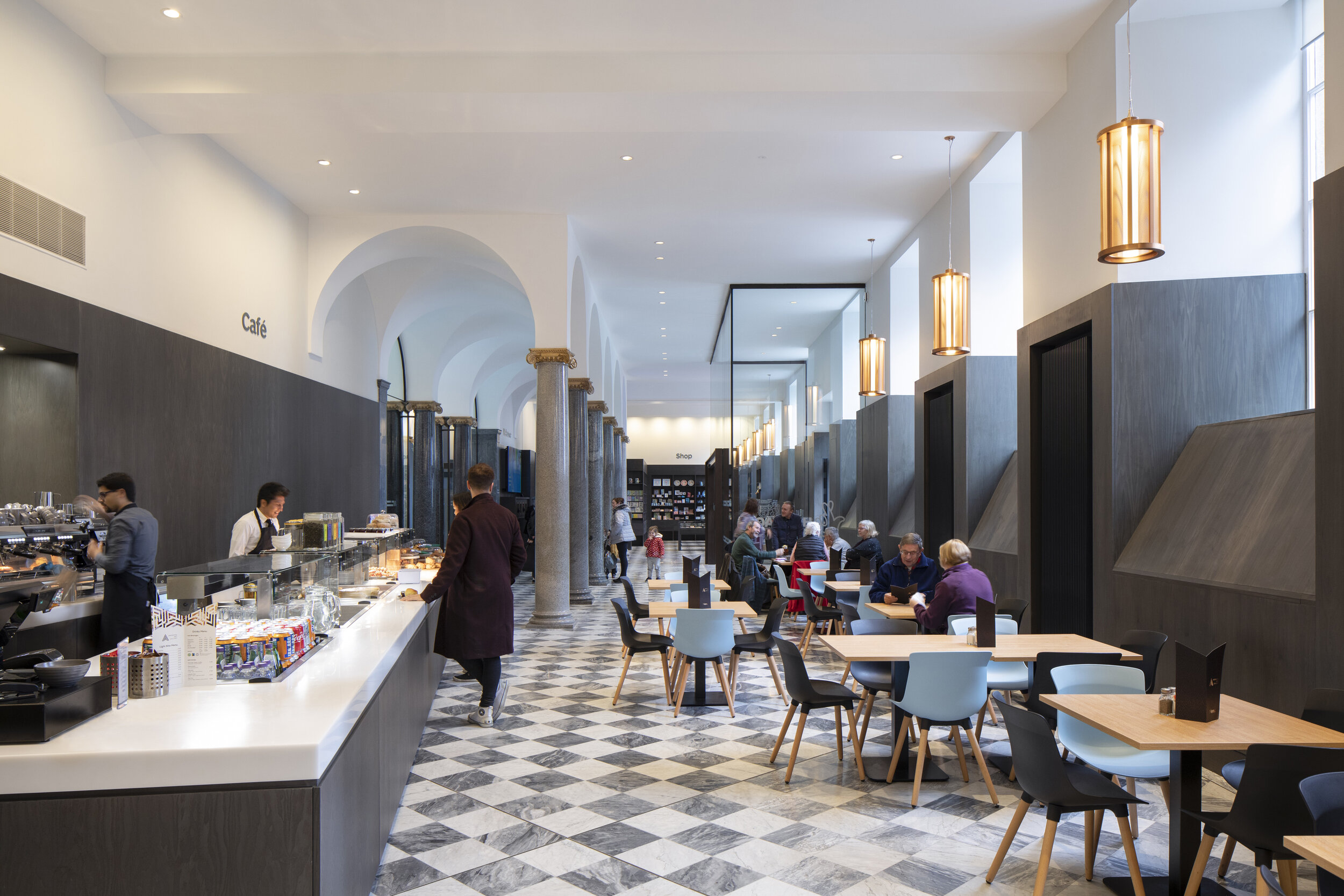SUPREME AWARD
Hoskins Architects
Aberdeen Art Gallery
THE PROJECT
Aberdeen Art Gallery is home to one of the finest collections in the UK. In 2009 Hoskins Architects won the national competition to redevelop and expand the A listed Gallery complex, comprising Art Gallery, Cowdray Hall and War Memorial, and set out on journey with Aberdeen City Council and their team at the Gallery to create a world class visitor attraction.
The completion of the £34.6million project in 2019 saw the refurbishment of existing fabric and systems, the number of galleries more than doubled and a bold new extension added, allowing the Gallery to completely revamp their offer.
“An outstanding project whose sum is greater than the collection of its parts”
THE STORY
Hoskins Architects was appointed to the redevelopment of Aberdeen Art Gallery in 2009, and the completion of the project in 2019 is the culmination of a decade of intensive, creative and collaborative work with Aberdeen City Council; the team at the Gallery; internationally respected consultants and specialists; funders, stakeholders, contractors and visitors.
By 2009 the category A listed complex no longer met the demands of the institution or did justice to the outstanding collection, and was failing to fully engage visitors and the wider public. Issues included failing building fabric and systems; inadequate art handling facilities and access; perception from the street and a lack of accessibility, intuitive wayfinding and clear circulation within.
There also existed a pronounced ambition to dramatically improve the scale and quality of cultural activities, requiring more gallery space to show more of the collection, and major new, dedicated temporary exhibition spaces to attract international touring exhibitions to Aberdeen.
Hoskins Architects and the team embarked upon a programme of careful research, to develop a robust understanding of the relative significance of the parts of the complex, culminating in a strategy with two main threads – one of careful repair, the other of confident addition. A programme of repair was focused both on making-good defective fabric and systems and addressing the damage done over time to the clarity of the original spaces, the relationships and routes between them.
The Remembrance Hall was brought fully into the gallery circulation route and made accessible across two levels. The Front Range was cleared to create a welcoming, spacious, bright and visible entrance space offering clear views into the Sculpture Court beyond and properly connected public routes into the Cowdray Hall and Remembrance Hall.
More dramatically, the entire roof, confirmed through surveys to be in need of complete renewal, was removed, and a new copper-clad rooftop extension built onto the existing granite walls. This houses new flexible, naturally lit temporary gallery spaces, as well as new exhibition space overlooking the Sculpture Court, an education suite, and additional cafe facilities adjacent to the public terraces.
“The rooftop’s coppered galleries have at last established the building’s proportionate presence on the city skyline”
The 130-year old Category-A listed building and its streetscape have now been re-designed to meet the needs of all visitors, creating level access to the Art Gallery from Schoolhill and throughout, as well as incorporating a new passenger lift.
In addition to accessible toilets on all floors there is a Changes Places Toilet, which incorporates a height adjustable adult-sized changing bench and a hoist system. Other features include Induction hearing loops at points throughout the building, a British Sign Language (BSL) events programme and a programme of Visual Description Tours (planned for early 2020). Dementia-Friendly events will also be hosted and quiet time throughout the gallery will be designated on a Monday afternoon.
Improving wayfinding across the three Grade A listed buildings – the Gallery, Remembrance Hall and Cowdray Hall – was a crucial objective. Critically, the Remembrance Hall, a dramatic and powerful civic space, was brought fully into the gallery circulation route and made accessible across two levels. Likewise, the Front Range, with inadequate toilets, unwelcoming café and shop spaces, and a poorly configured staircase, was cleared to create a welcoming, spacious, bright and visible entrance space, offering clear views into the Sculpture Court beyond, and properly connected public routes into the Cowdray Hall and Remembrance Hall.
New, temporary gallery spaces within the new rooftop are conventionally air conditioned to ensure utmost flexibility in meeting the demands of international touring exhibitions; a different approach has been taken to the redeveloped gallery spaces within the existing buildings, however.
Here, a number of factors, including the necessarily air-permeable fabric of the mass masonry existing construction and the impossibility of weaving major AC ducting routes through sensitive rooms, made conventional HVAC unfeasible, as well as carbon-intensive. Instead, a fundamentally low energy approach has been taken.
Extensive fabric repairs were undertaken, replacing defective pointing, copper sheet work, fibrous plasterwork and lath and plaster as well as restoration of historic paint marbling. Carefully considered envelope upgrades were also implemented – where internal linings were less significant, these were removed, and a breathable insulation system installed (wood-fibre insulation boards bedded on a clay parge coat).
These envelope upgrades, leading to improved airtightness and insulation levels, enabled a passive environmental control strategy to be implemented in the existing building – a significant achievement for a museum and art gallery.
Natural ventilation with pre-tempering and local humidification avoided the need for conventional air conditioning, which would have been costly in terms of both energy and loss of original fabric to facilitate air handling service routes. Most galleries are naturally lit, and artificial lighting is low-energy LED throughout
External walls have been upgraded where possible, and double-glazed heritage windows introduced to reduce fluctuations in environmental conditions. Glazed lobbies and baffle screens around the entrance area limit uncontrolled air infiltration into the exhibition spaces. Air is brought into galleries in a carefully controlled way, through concealed louvres, across local coil heaters for tempering, and into galleries via a plenum and grilles.
THE GUEST JUDGES COMMENTS IN FULL
“The Aberdeen Art gallery refurbishment and extension has been conceived and executed in highly skillful way that showcases the original building whilst subtly playing with less successful subsequent additions to create clarity and urban engagement. The new building shows boldness and precision embracing the War memorial and Cowdray Hall for the first time. The roof top addition is both sensitive and challenging making a grand civic statement. This architectural response has delivered an outstanding project whose sum is greater than the collection of its parts.”
John McElgunn, Rogers Stirk Harbour and Partners
“Whilst clear that we must applaud the ten-year commitment of both client and architect to this project, it is from their recognition of the building as a live work, of 130 years, that its many successes emerge. The rooftop’s coppered galleries have at last established the building’s proportionate presence on the city skyline whilst a softening reformation of its entrance façade looks ready to welcome both returning visitors and wavering newcomers alike. It has been a pleasure to learn about this building and we look forward to the freedom to head up to Aberdeen soon.”
Thom Brisco, Alder Brisco Architects








